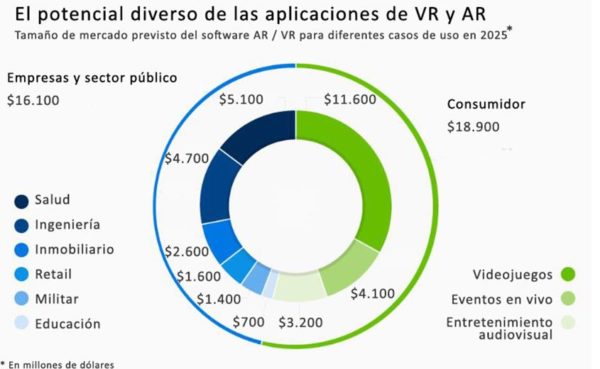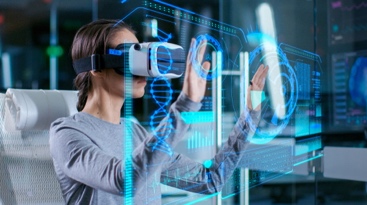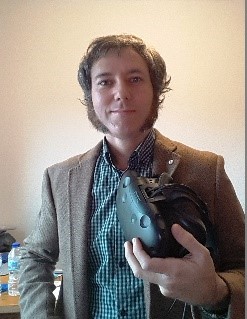The digital transformation has reached the industrial sector with the implementation of hyper-connected factories that allow access and the possibility of modifying, in real time, production system processes and resources. An industry 4.0 where the connection between new technologies has enabled the creation of an organizational and control model aimed at improving productivity and security, with virtual reality as a reference point for risk prevention systems.
This new industrial revolution has given rise to intelligent factories that incorporate innovative features such as cloud computing, the internet of things, the integration of data, and various technological advances in production systems. In this context, “virtual reality is highly able to relate to other technologies present in the industry,” says Ángel Gil, an expert in industrial security and CEO of the technological company RenderSide. This assertion is based on basic examples, since it has the capacity to provide coverage when it comes to viewing data resulting from a Big Data context, to remotely control manufacturing robots or control drones, or to tangibly represent cyberphysical spaces corresponding to the concept of IIoT (Industrial Internet of Things).
Specifically, Ángel Gil points out that there are three major areas of virtual reality (VR) impact in the industrial sectors:
– Training “Obtaining the knowledge, ability and motivation of a worker exposed to this technology” thanks to training and evaluation tasks at risk control level. In this sense, he highlights the application that has been developed by RenderSide for CESVIMAP, where workers can enhance their skills in identifying fraud by stealing different elements of a vehicle.
– Designs of facilities or equipment “The ability to ‘feel and experience’ your own engineering or architectural model” through 3D visualization work that facilitates predictive maintenance and remote machinery repairs, as the operating state of the machine (temperature, combustion, rotation speed, etc.) can be known in real time to predict the wear of any of the components.
– Commercial “Ability to excite the person exposed to the experience” if virtual reality is applied to commercial activities for advertising and product sales, allowing “the user to be transported to a synthetic environment generated entirely by the computer, within which the user can experience everything that has been programmed and designed for that purpose.”
Simulations to improve safety
As Ángel Gil affirms, VR technology focuses on the worker as a source of accidents in the field of industrial safety, which causes the spectrum of risks to be prevented to be very high, depending on the danger associated with the company. As an example, he explains the case of a facility with explosion risk and/or Seveso (Community directive on the control of major-accident hazards involving dangerous substances) scenarios. “The VR application will focus on providing the critical task manager within this facility with the highest number of ‘flight hours’ in a simulation environment. This environment will be controlled and programmed with the intention of increasing the degree of knowledge and skill of the corresponding worker,” he argues.
The impact of virtual reality on industry will especially impact three areas of work: training, the design of equipment and facilities, and commercial
This model highlights how virtual reality training provides all staff involved with basic training in risky situations. In this way they can learn the techniques to control the operational control panels and the appropriate procedure to follow in critical situations (in conjunction with specialized personnel).
Along these lines, the company Six Dimensions (6D Lab), together with the Mapfre Foundation and the Science Park of the Carlos III University of Madrid (UC3M), has developed an initiative to generate hyper-realistic simulation environments using VR with a total immersion level, in which the employee faces extreme risk situations, such as a fire in a building. This tool allows the development of training focused on how to proceed in the event of an incident thanks to two elements: the Eye-Tracker system, which helps to know where the individual looks during the experience (providing data on how long it has taken them to see the fire, whether or not they have been guided by emergency signals, etc.) and a heart rate monitor, which provides information on the level of anxiety suffered by the user during the drill.
Sectors especially impacted
Although virtual reality is a technology that until a few years ago was very focused on the leisure and entertainment industry, these progressive advances in research have made it possible to perfect procedures and to lower costs, facilitating access to other branches of industry in which improvements in productivity are especially noticeable thanks to the automation of processes. “The sectors where the greatest use of immersive environments is evident are those where visualization and experimentation provide added value,” comments Ángel Gil.
Precisely, the advantages of virtual reality become more evident in those sectors where workers are part of the productive process and their training involves personal or infrastructure risks, since it facilitates multipresence and delocalized instruction. For this reason it has become a new area of activity in the oil sector, as its operators can be taught in virtual environments, simulating platforms without exposing them to the risks involved in on-site visits and establishing action protocols in a safe environment at a lower cost.

Source: “Virtual and Augmented Reality. Understanding the Race for the Next Computing Platform,” by Goldman Sachs Group.
In the automotive industry, these impacts are particularly noticeable in design, manufacturing and safety processes. Industrial prototyping is allowing engineers to see what the final version of a vehicle would be like and how it would work without having to manufacture it. In addition, multiple tests can be carried out on the engine or internal elements of the car, achieving considerable savings in economic resources and materials. It also facilitates the access, capture and sending of digital information on the models in real time, which is integrated and stored in the ERP system for improvement.
Virtual reality not only helps in the profiling of models, but also favors the safety of automobiles, by allowing simulations of situations of potential risk in external environments – both when the vehicle is being constructed and in crash tests. This anticipation means that design or working environment problems can be identified that would not usually be seen before the prototypes are already manufactured.

The simulations also allow the employee to be trained in the use of heavy or dangerous machinery, as well as to be aware of the occupational hazards of certain facilities without being exposed to them during the training period. This procedure has allowed NASA to simulate the International Space Station in order to train its astronauts from Earth, in addition to advancing its research.
The application of VR will have a special impact on civil construction, the sector with the highest accident rate in recent decades. The immersion capacity that it offers will help to visualize the work in a virtual way and, therefore, also the possible risks, so that the dangers can be known and the prevention measures improved. In addition, it helps to reproduce emotions so often felt by the workers of the major jobs, such as stress, anguish, vertigo or speed, recreating the different situations in which they can be experienced, to help to prevent and mitigate their harmful effects.
The simulations allow the employee to be trained without being exposed to occupational risks during the learning period
Overcoming the fear of change
However, major obstacles are being posed by industry sectors for the final implementation of this and other types of virtual reality devices, affecting their ability to penetrate. “The very ignorance of VR technology in terms of its use and the great possibility of solutions and actions that can be taken from it,” notes the CEO of RenderSide. In many cases, this translates into the entrepreneur believing that its implementation involves making large investments “when in the vast majority of cases, this is not the case.”
However, carrying out a simulation with physical elements involves a much higher logistical cost than a virtual one. And with virtual ones, risk situations or specific industrial environments can be used over and over, and different test models can be adapted, without this causing deterioration to the real materials that need to be replaced.
Ángel Gil adds that, faced with this stumbling block, the industry is fortunately overcoming another that has been halting its development: the change of mentality. More and more professionals appreciate that the application of virtual reality technologies will not replace industrial processes and work modes that have been developed until now, but complement them to obtain greater added value. “Today, the new digital transformation paradigm that helps to confront the concept of fear of change, backed by the existence of real data from the incorporation of immersive technology within a company, is beginning to take hold,” explains the CEO of RenderSide.
That is why one of the main challenges of virtual reality is to establish itself in large companies as a “daily tool to cover a need; in order for this to happen, people must be familiar with the technology and the benefits it provides, and the VR itself will have to adapt more and more to the needs of the entrepreneur,” says the expert.
In this respect, he embraces the fact that the next advances will move in this direction. These include the imminent arrival of autonomous virtual reality glasses, which will facilitate the whole experience as they do not need to be connected to a computer, but can rather be self-sufficient when it comes to managing applications such as Oculus Quest: “This technological solution is mainly aimed at industrial sectors and could lead to greater interest in the sector when it comes to incorporating immersive solutions,” concludes Ángel Gil.
This article was written with assistance from
 Ángel Gil is an industrial engineer with an official Master’s degree in Graphic Programming and Virtual Reality, specializing in Advanced Simulation, as well as a Master’s with distinction in the Prevention of Labor Risks. He has more than ten years of experience in the Industry sector, in the areas of Industrial Safety and the Environment, thanks to his work in international consulting and insurance companies. He previously held the position of technical head of the HSE Department at MAPFRE Global Risks, and after his time at Next Limit, where he gained experience in the development of advanced simulations within digital environments, he founded RenderSide, where his two areas of expertise go hand in hand: risk engineering and graphic programming.
Ángel Gil is an industrial engineer with an official Master’s degree in Graphic Programming and Virtual Reality, specializing in Advanced Simulation, as well as a Master’s with distinction in the Prevention of Labor Risks. He has more than ten years of experience in the Industry sector, in the areas of Industrial Safety and the Environment, thanks to his work in international consulting and insurance companies. He previously held the position of technical head of the HSE Department at MAPFRE Global Risks, and after his time at Next Limit, where he gained experience in the development of advanced simulations within digital environments, he founded RenderSide, where his two areas of expertise go hand in hand: risk engineering and graphic programming.





